The most popular case type across MBB firms is profitability and you will most likely encounter at least one. Understanding the framework specifically designed for that type of problem is crucial. In this article, I will show you how to use this framework in case interviews – from the fundamentals to instant-result tips to land one of the most prestigious job offers out there!
Table of Contents
What is the profitability framework?
What is the profitability framework?
Profitability framework is a special-designed issue tree to solve Profit problems in consulting case interview. The framework starts with a math equation: PROFIT = REVENUE – COST then consequently breaking down each branch (REVENUE and COST) down into smaller components such as: Price x Quantity or Cost/Unit x Quantity.
But hey, what is a case interview framework in the first place?
A case interview framework is a template used to break down and solve business problems in case interviews. A framework can be highly customized for specific cases or versatile enough for general problem-solving. Some popular frameworks are: Profitability, Market Entry, 3C&P, or the marketing 4P.
The most important thing to remember when using frameworks to solve a problem is to be FLEXIBLE. Consulting problems are complex and usually there are no clear-cut, ready-to-use frameworks to solve them. The interviewer looks for context-relevant frameworks, not complicated but inappropriate ones.
Hence, the more you master the “building-blocks” frameworks, the better you can draw specific frameworks suitable to each context. Learn more about frameworks.
Diving into the “profitability framework”
The nice thing about Profitability Framework is that it is entirely based on different Math equations. That allows for flexible use in case interviews with many different variants, allowing figures to be viewed from different angles for multiple insights. Moreover, most of the data are easily accessible from the company’s financial reports.
On the highest level, everybody agrees that: Profits = Revenues – Costs. But down to lower layers, there are a number of variants. But the main idea is to keep using math to break every branch down until the case shows its true self.
Here is one example of a variant. We will introduce to you 6 of them later in this post. Keep reading.
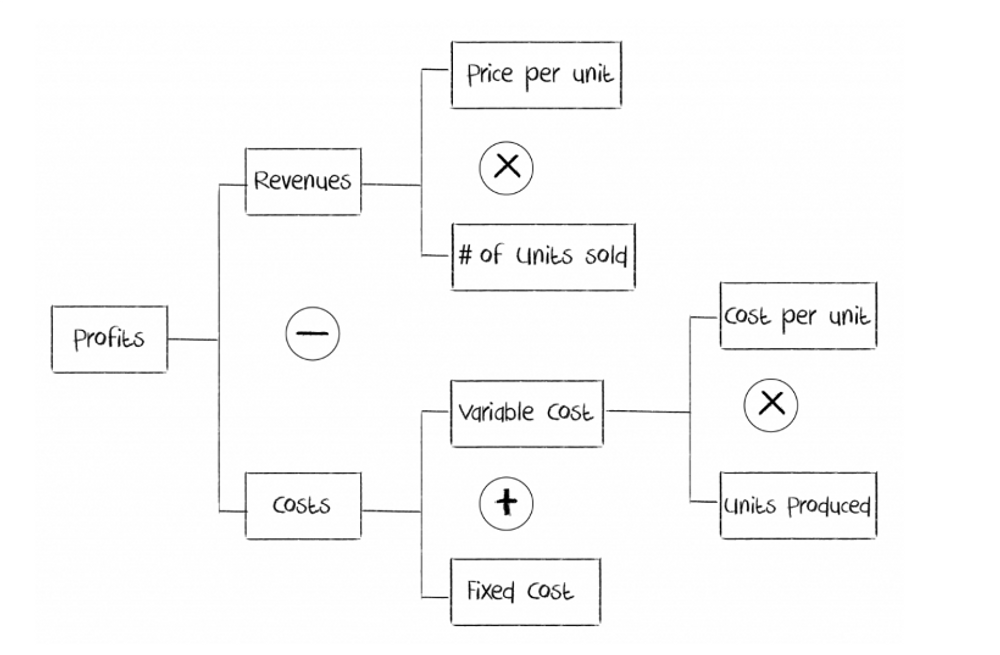
Understand the profitability cases?
Profitability case is one of the most popular case interview problem types, often given in the format of a client facing declining or negative profit. The consultant’s job is to analyze the situation, identify the root-cause, and propose solutions. Almost all Profitability cases start with a Profitability Framework and slowly transition themselves into qualitative issue trees.
Here are some examples of profitability cases:
- Profit problem: Alice’s hotel chain has been experiencing profit stagnation for 6 months despite an increase in customers, they want to understand why?
- Loss problem: Bob’s restaurant has been operating at a loss for 3 consecutive months despite having raised their menu price. They want your help to make the business profitable again.
- Revenue problem: Han’s marketing agency has seen total revenue decline for 2 years despite significant cuts in back-end costs, they want to know what’s causing it.
While the most popular Profit cases are asked in the form of “Problem – Find root-cause – Solutions”, occasionally the interviewer may also give you the “Yes/No” or “How-to” cases:
- “Boston Electric is planning to acquire a very expensive set of equipment to expand their production. Is this a good idea?”
- The Coffee House is planning to launch a new store in a nearby city. How to do it in the most Profitable way?
In this article, I will focus mainly on the “Problem – Find root-cause – Solutions” type. It is the most popular format and studying it will show you the big picture quickest. Once you grasp the format, you can easily apply the principles to other formats.
Six variants of the profitability framework
Variant 1: Unit price/costs x quantity (both sides)
This is the most popular and rudimentary variant of the profitability framework, with a logically simple mathematical structure. This variant is often used for cases where the unit sale of ONE particular product is important (for example, in single-product businesses).
This variant has two drawbacks: it cannot be used for multiple product lines at the same time, and it’s not strictly MECE. (price and quantity are fundamentally related – lower price tends to increase quantity, and vice versa – that means the root cause from one branch may manifest in the other, making it harder to isolate).
Case Example
A local ice-cream business finds its profits deteriorating in the last two years. They have hired you – an independent consultant – to find the root cause of their problem and fix it.
Now, if this business only sell one type of ice-cream, this is how we can break down their profits:
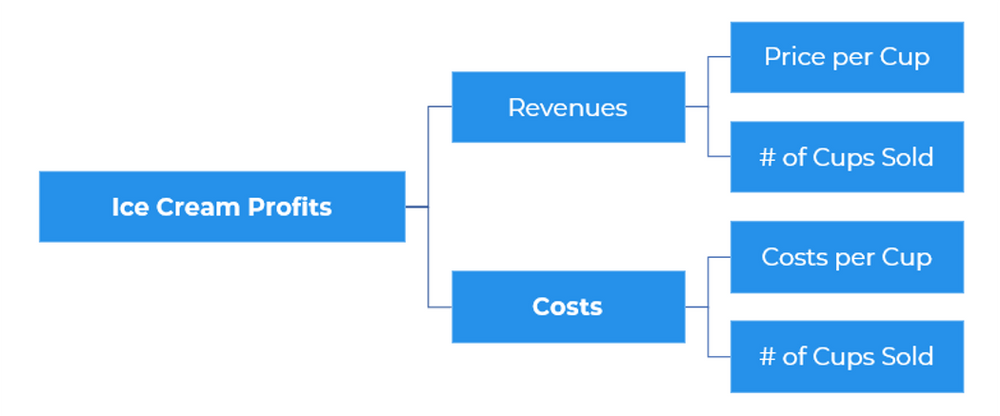
Variant 2: Revenue/cost per customer x number of customers (both sides)
This one is a spin-off of Variant 1, with units of goods exchanged for customers. This variant is often used for businesses where the spending of each customer varies significantly (say, a supermarket or a restaurant).
In contrast to Variant 1 the business has one or many product lines is not important, and there’s less correlation between the two branches (more MECE).
If the shop in the previous example has 3 types of ice-cream and also sells optional toppings to eat with the ice-cream – say, strawberries -it wouldn’t make any sense to put them all into one group. The price variations between each cup, with three types and toppings added, can be quite remarkable, so Variant 2 should be used:
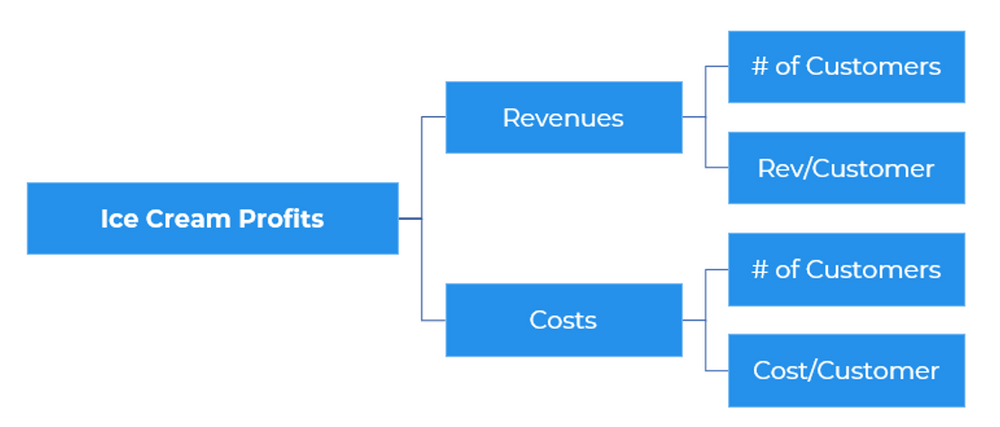
Variant 3: Segments/business lines (both sides)
Variant 3 divides the revenue side into corresponding market segments or business lines in a MECE way (more so than the first two variants). If the case concerns many product lines or market segments, and you suspect the root cause comes from one of them, use this variant.
This variant and its spin-offs (4 and 5) tend to be more MECE than the first two, but it cannot answer “why” the problem is happening, only “where” – to answer that “why” question you need to revert to the first two variants to break down the data, then switch to qualitative frameworks to answer the case question.
In the ice-cream case, if the root cause of the business’ problem comes from competition in the chocolate ice-cream line, neither Variant 1 nor Variant 2 can isolate it. The below issue tree, on the other, would certainly reveal that problem:

Variant 4: Non-operating vs operating (revenue side)
Variant 4 is basically Variant 3 for businesses which regularly engage in activities outside their core services/products. It divides revenues into operating revenue generated from selling the business core products/services, and non-operating revenue from investments or sale of assets).
For example, if the ice-cream business also owns a few shop-houses for leasing to other businesses, here’s what their revenue would look like:

Variant 5: Functions/cost types (cost side)
Variant 5 is similar to Variant 3, using the source of cost as the basis for segmentation – but only applies to the cost side. This variant is useful for cases where the root cause comes from one particular function of the company (such as HR, Marketing, Sales, etc.).
Here’s Variant 5 applied to the ice-cream case given above:

Variant 6: Fixed vs variable
Variant 6 uses accounting concepts to break down the costs of a business, much like Variant 4 on the revenue side. The most popular form of this variant is “Costs = Fixed Costs + Variable Costs”, shown below; this form is fundamentally MECE and applicable for every business, however, each branch must always be divided into many sub-branches (using the previous variants).
Here’s Variant 6 applied to the ice-cream case given above:

Combinations, spin-offs, and qualitative frameworks
In real case interviews, you need to use a combination of the above variants – mostly because each variant has its own strong and weak points, and none of them can deliver an in-depth analysis of the problem on their own. Being creative enough to draw customized versions of the aforementioned frameworks is likewise crucial to passing the case interview.
However, many times numbers alone cannot get you to the root cause of the problem – and that’s where qualitative frameworks come into play.
Switching to qualitative frameworks
Sometimes, quantitative frameworks like the profitability framework cannot take you to the root of the problem. In such cases, the solution is to switch to qualitative frameworks to find the root-cause. It’s like going on a picnic by a lake inside the forest: your car can only take you from home to the edge of the forest, you will have to navigate through the forest to the lake, on foot.
Case example
A major fashion retail chain has been operating without profits for the past 6 months. They hire you to investigate and deliver a solution.
Having applied the profitability framework, you determine that the problem comes from excessive HR costs. HR costs are a product of the number of employees and HR costs per employee (so they either hire too many or pay too much). After gathering more information, you found out that the company is over-hiring. At this point, you suddenly find yourself stuck. Now what? Why is the company overhiring? How can you fix that problem?
This is a typical “stuck” situation in profitability cases; in this section I’ll guide you through 3 simple steps to get out of it.
Step 1: Exhaust the math structure
In any profitability case, the first thing you need to do is to keep drilling down mathematically. Simple as it looks, it is a very effective tool to find root causes and deliver on-point solutions.
Most importantly, don’t be nervous when the math does not take you to the root cause just yet. In case interviews, focus on exhausting the framework really well at the beginning, because that’s where you’ll score most points. The interviewer will have made a decision in mind if you break down the issue really well. In tricky cases, he or she will give you a few hints to get to the bottom of the root cause.
In the given case, if you just stop at “over-hiring”, you can’t deliver a practical solution – because you haven’t broken down the case enough to reach the root cause. You don’t simply fire half your employees overnight indiscriminately.
Step 2: Gather as many insights as possible
The second step is to gather as many insights as possible about the company and the case context. This helps identify the most likely branches to contain the root causes.
Once you have reached the end of the quantitative framework, you will face what can be considered a mini case in itself. This mini case requires its own frameworks or systematic approach to find the root cause. For example, in the above case, the new mini case is: “How to reduce excess numbers of employees?”
The kinds of branches you draw next will entirely depend on the context and situation of the company you’re advising, which vary case by case. In other words, the qualitative traits of each company together determine how each framework will look like. That is what I mean by “qualitative framework”.
Applying to the case above, some company-specific, insight-revealing questions you might ask are:
1. What are the sources of HR costs?
2. Among those sources of costs, which one is the main contributor?
Suppose, for the first question, you find out that the two sources of costs are:
- Salaries of employees in office departments (office salaries overhead)
- Labor cost to operate day-to-day business activities in retail outlets (outlet labor costs)
For the second question, you might find two possibilities:
- Office salaries overhead is the main contributor
- Outlet labor cost is the main contributor
At this point, you need to dig deeper. Ask more questions and gather more facts
1. If office salaries overhead is highest, is the company having excess employees in one or more departments compared to our competitors?
2. If outlet labor cost is highest, how many employees does the company have per store? Is it optimizing its outlet workforce? What metric is it using to allocate employees
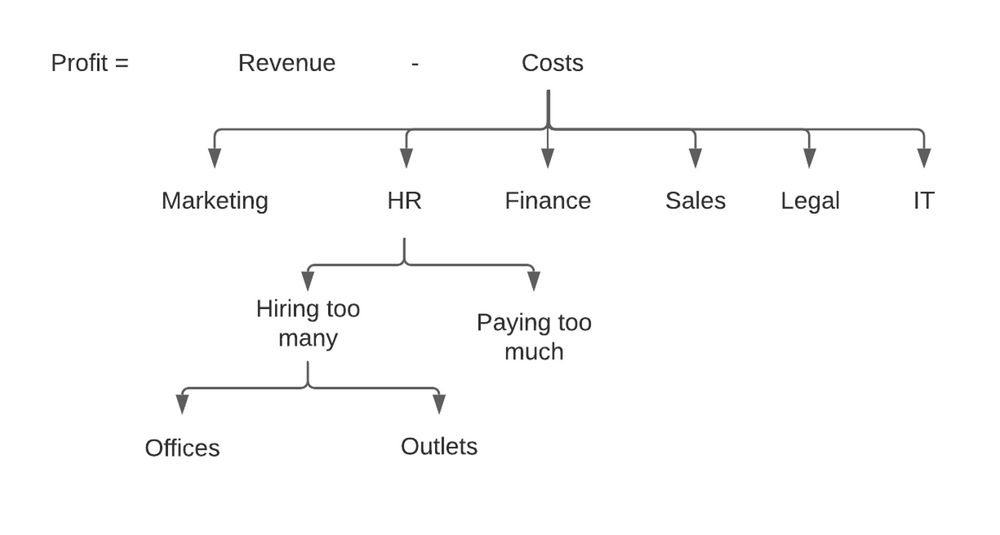
Step 3: Apply insights to the framework
At this stage, drawing qualitative issue trees is usually easier than the first stage, a.k.a using the quantitative framework to break down the problem at the beginning of the case. Here’ when you add gathered contextual insights into the framework and derive suitable qualitative variants.
To continue with the case above, suppose the source of high HR cost is hiring too many employees at store outlets. If this is the case, you need to determine which stores are having too many employees and why. In other words, you are looking for outlets in which labor is not being optimized and the reasons behind that.
There are several interrelated variables to consider when ranking all outlets to pinpoint ones where employees are not being allocated efficiently:
1. Store sales: what is the sales to employees ratio for each store?
2. Store size: what is the store size to employees ratio for each store?
3. Customer traffic: what is the customer traffic to employees ratio for each store?
Five tips when using the profitability framework
Tip #1: Strictly follow the problem solving methodology
The Profitability Issue Tree is very easy to follow. So the interviewer can also easily catch it if you deviate from the standard Consulting Problem Solving Methodology. Here are some of the common mistakes that may sound silly but I keep seeing candidates making them over and over again:
Going to Layer #2 without testing Layer #1 first
For example: you break down the problem into Revenue and Cost (this is Layer #1), you decide to tackle Revenue first. And here, without confirming Revenue is problematic, you immediately go down into Price or #Unit. This is not logically sound. You can and you should only go down to Layer #2 (Price, #Unit) if you know the Root-cause IS in Revenue.
Going to Layer #2 even though the branch doesn’t contain the Root-cause
For example: you break down the problem into Revenue and Cost. You test Revenue and there is nothing wrong with it. You keep going down to Price and #Unit (Layer #2) … just for the sake of going down. If there’s nothing wrong with Revenue, don’t waste anytime. Move to Cost!
Moving to other branch without closing the deal with the current branch
For example: you are on the Revenue side and there are signs that the Root-cause is here. You break Revenue down to Price and #Unit. You analyze a bit, hit a deadend, and decide to go to Cost. This is not logically sound. Try to exhaust Revenue (a.k.a: identify the Root-cause in there or conclude Revenue is NOT the problem) before moving to Cost!
Tip #2: “Pretend” to be hypothesis-driven
The Problem Solving Methodology tells us to be “hypothesis-driven”. What does it mean? It means to look for the root-cause with some educated guesses in mind, a.k.a: to draw the issue tree that isolates potential root-causes. But isn’t it so obvious that we would almost always break down Profit into Revenue and Cost, right?
So the answer is to do whatever you need to do with the issue tree (a.k.a: breaking down Profit into Revenue and Cost). But as soon as you step into Revenue or Cost (the first layer =), say it’s the hypothesis that carries you there.
“I hypothesize that the Root-cause is in the Revenue branch. So I would like to test Revenue first. Here are some of the data I need … etc.”

Tip #3: Get a feel for the case and decide on the specific variant
The first Layer is quite straight forward but the deeper you go, the trickier it gets. You need to use business intuition and contextual insights to decide which variant to use.
Contextual insights can be gained by asking the interviewer – in fact that’s what you’re supposed to do in a case interview, as you are not allowed to bring outside knowledge into the case. That said, knowing how to ask is extremely important – you must always show a purpose when asking for context or any data. “To get a feel for the case and draw the most relevant issue tree” is a perfectly valid excuse – I tend to use it at the beginning of the case when there is hardly any data to make informed decisions.
However, context can only make sense with business intuition – which can only be gained through exposure. Read consulting and business news, do mock cases, slowly your intuition will build up. This part of case interview is covered by our Business Intuition package of the Case Interview End-to-End Secrets Program, which uses unconventional cases to prompt the development of intuition.
Tip #4: Use your good old math friend before flirting with qualitative ideas
Quantitative analysis is always easier than qualitative. For example: you figured out that there is definitely something wrong with employee cost. Don’t try to understand why yet. Don’t ask for company’s organization charts, don’t try to understand the human structure yet. Keep using math until you can’t anymore.
In this example, you can continue to break Employee Cost down into #Employees and Average Salary. Even if this breakdown doesn’t yield any important insights, it’s worth the try. Because when it does work, you save yourself a ton of hassle.

Tip #5: Have a personal script
You can save valuable Brain Power for what really matters the most. So if anything can be prepared beforehand, do it. This is so important that the whole next section will be dedicated to it. Keep reading!
See more helpful tips for the profitability framework in our Case Interview End-to-End Secrets Program. To know if you’re on the right track, you can also book a meeting with former consultants who have insider knowledge of what makes you fail in a case interview. They will give you a real life mock interview and quickly identify your improvement areas.
Developing a personal pcript
Organize what you are going to say into a script, and practice a hundred times.
Let’s be honest, sounding structured and professional in any case interviews costs a lot of brain power. Particularly, in profitability cases, you are better off maximizing your time and effort breaking down the problem, not smoothly translating from the math language.
Hence, I recommend practicing all the formulaic lines, such as the opening or data requests, using an interview script. Practicing is really the only way you can unconsciously sound structured and professional. With enough training, those lines will feel natural to you.
Here’s an example of a good practice script:
| Phase | Script |
|---|---|
| Case example | Mondali – a major chain of clothing retail had been operating at a loss for the past 6 months. The CEO hired you to investigate to help the company regain profits. |
| Greetings | Good morning Mr. ABC. Thank you for the time. How are you doing? |
| Opening | This is a very interesting case. Thank you very much. The first step in solving any problem is actually to make sure you solve the right one. So before getting into my approach, I would like to (a) make a recap of the case and (b) ask a few clarification questions. Sounds good to you? So (a), to recap, No.1: Our company is in the apparel industry, more specifically clothing retail. No.2: They have been running at a loss for 6 months and the CEO wants to reverse this trend And (b), for clarification questions, No.1: Has the company experienced any significant increase in cost for the past 6 months, related to overall functional costs? Yes, there has been an increase in overall functional costs. No.2: Has there been an increase in the volume of sales and total revenue? Yes, sales and revenues have increased slightly in the past 6 months. |
| Getting into the content | Thank you for the clarification. So a systematic way to tackle this problem, that creates long-lasting impact, is to do it from the root. So my approach is to search for the root-cause of the problem. To do that, the most effective yet efficient way is to break the problem down into smaller pieces in a MECE way. Once we find the root-causes, we will discuss solutions to fix them. Is this approach ok to you? |
| Proposing an issue tree/framework | Great! So now let’s draw out an issue tree to break the problem down. A good issue tree is the one that is MECE and can help us successfully isolate the problem. We may need to try more than one. But at this point, as the case indicated that revenue increased because sales increased (the reason for your issue tree), a good way to start is to look at it through different types of costs: Marketing, HR, and Finance (describe angles of your issue tree)… Do you have other thoughts? |
| Going into the first big branch | Unless you think otherwise, let’s hypothesize that the root-cause lies in HR cost (your first big branch). 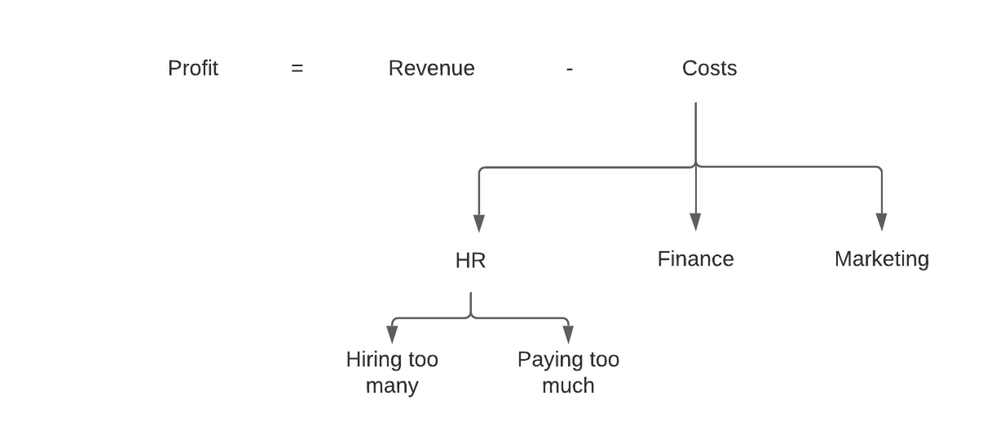 |
| Testing hypotheses | To test this hypothesis, I would like to look at HR costs for the last 6 months and compare that with that of our competitors (your benchmarks, tests, questions, etc.) …This data is often available through company quarter or annual reports/ financial statements, or third-party reports (the typical sources of data) … |
| When receiving a piece of data, chart or exhibit | This is very interesting, the cost in Jan 2019 is $1.5M, as opposed to $3M in July 2019 (make data recap or ask clarification questions if necessary) … In the evaluation of this interesting data, here are a few insights I notice: No.1 is that total cost has doubled within 6 months No. 2 is that total cost as of July 2019 is $1M above the industry average. This means that overall, HR costs have increased in the past 6 months, which might have led to a fall in profits and eventually result in losses. |
| Confirming/disproving the first big hypothesis | Confirm: Ok so with that data, we know that the root-cause indeed lies in this first big branch, HR costs. Let’s go down one level deeper to find out where that is. If disprove: Ok so with that data, we know that the root-cause does NOT lie in this first big branch. We can cross it out in our analysis. Let’s hypothesize that the root-cause lies in … (name of your next big branch). |
| After identifying root causes (repeat hypothesis testings until you find the root cause) | Ok following rigorous analyses, we have identified one (a figure) root cause, that is, the company is hiring too many employees. The next step for us is to work out solutions for this identified root-cause. |
| The “map habit” | I would like to make a recap of where we are in the big picture: the company was operating at a loss because it hired too many employees, leading to an increase in HR costs and total costs and hence a decrease in profit (your recap)… Next, I would like to find the stores that were having too many employees using three criteria: store sales, store size, and customer traffic. Having pinpointed these stores, I will then investigate the underlying reasons for this excessive labor hiring. |
| CEO pitch | Mr. CEO, it has been my great pleasure to be a part of this very interesting project on Mondali’s case (case problem). We have identified the following root-causes: hiring too many employees (state the root-causes in a numbered fashion) To solve the root-cause, we have laid out a set of actions: No.1: Find the stores that were having too many employees using three criteria: store sales, store size, and customer traffic (state the actions in a numbered fashion) No. 2: Investigate why these stores have too many employees by testing several hypotheses: poor employee training, sales loss because employees are bogged down by manual tasks, etc… We would be more than happy to work with you on future projects, implementing those initiatives. Thank you very much. |
/filters:quality(75)//case_thumb/1669783363736_case_interview_end_to_end_secrets_program.png)